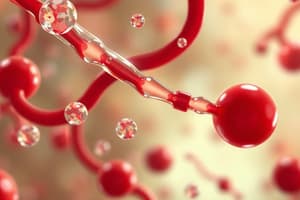Podcast
Questions and Answers
What are the three major elements leading to VTE, as described in Virchow's Triad?
What are the three major elements leading to VTE, as described in Virchow's Triad?
- Stasis in blood flow, Vascular endothelial injury, and Hypercoagulable state (correct)
- Stasis in blood flow, Vascular endothelial injury, and Hypertension
- Vascular endothelial injury, Hypercoagulable state, and Vasospasm
- Stasis in blood flow, Hypercoagulable state, and Atherosclerosis
What is the result of reduced blood flow rate on the clearance of activated clotting factors?
What is the result of reduced blood flow rate on the clearance of activated clotting factors?
- Unclear relation between blood flow rate and clearance of activated clotting factors
- Increased clearance of activated clotting factors
- No effect on clearance of activated clotting factors
- Reduced clearance of activated clotting factors (correct)
What is the function of endothelial cells inside blood vessels?
What is the function of endothelial cells inside blood vessels?
- To promote platelet adherence and activation of coagulation cascade
- To create substances that inhibit platelet adherence and prevent activation of coagulation cascade (correct)
- To stimulate the immune system to respond to injury
- To facilitate vasospasm and vasoconstriction
What is the role of von Willebrand's factor (vWF) in platelet adherence?
What is the role of von Willebrand's factor (vWF) in platelet adherence?
What is the result of platelet activation?
What is the result of platelet activation?
What is the function of glycoprotein (GP) 1b receptors in platelet adherence?
What is the function of glycoprotein (GP) 1b receptors in platelet adherence?
What is the consequence of injury to the vessel wall?
What is the consequence of injury to the vessel wall?
What is the role of activated Protein C resistance in VTE?
What is the role of activated Protein C resistance in VTE?
What is the consequence of the additive effect of Virchow's Triad?
What is the consequence of the additive effect of Virchow's Triad?
What is the primary function of the hemostatic plug?
What is the primary function of the hemostatic plug?
Flashcards are hidden until you start studying
Study Notes
LMWHs
- Each LMWH has a slightly different molecular weight distribution and pharmacologic properties
- They exhibit less protein binding, resulting in a more predictable response
- They have a lower incidence of HIT and osteopenia
- Dosing is once or twice daily due to longer half-lives (usually 3-6 hours, but agent-specific)
- Half-lives are prolonged in patients with renal impairment, increasing the risk of drug accumulation and bleeding
- SQ bioavailability is >90%
- Peak effect is 3-5 hours after SQ dose
- Baseline prothrombin time (PT), INR, aPTT, CBC, and serum creatinine (SCr) should be obtained
- Platelet count should be checked every 2-3 days during the first 2 weeks and every 2-4 weeks with extended use
Mechanism of Action
- Halt propagation and growth of thrombi
- Anticoagulant effect is from AT binding
- Cannot bind AT and thrombin simultaneously
- Have greater activity against factor Xa
- Inhibit thrombin (IIa) to a lesser degree
- Xa:IIa ratio is anywhere from 2:1 to 4:1, depending on the agent
Dosing
- Dosing is based on patient's weight
- Dalteparin: 200 units/kg SQ daily or 100 units/kg twice daily
- Enoxaparin: 1.5 mg/kg SQ daily or 1 mg/kg twice daily
Clinical Presentation and Diagnosis
- Majority of VTEs begin in the lower extremity
- VTE symptoms are very nonspecific, including:
- Unilateral leg pain, warmth, and swelling
- Shortness of breath and/or cough
- Tachypnea and/or tachycardia
- Hemoptysis
- Objective tests used to confirm VTE include radiographic studies and D-dimer test
- D-dimer test can distinguish between acute VTE and PTS
Monitoring
- aPTT is the most widely used test for monitoring
- aPTT should be obtained at baseline, 6 hours after initiation, and 6 hours after each dose change
- aPTT should be 1.5-2.5x control value (reference value)
- CBC and BP should also be monitored
Virchow's Triad
- Three major elements leading to VTE:
- Stasis in blood flow (venous stasis)
- Vascular endothelial injury
- Hypercoagulable state
- These risk factors are additive
Pathophysiology
- Vessel injury leads to the formation of a hemostatic plug
- Inappropriate response can lead to clot formation
- Endothelial cells create substances that:
- Inhibit platelet adherence
- Prevent activation of coagulation cascade
- Facilitate fibrinolysis
- Injury exposes subendothelium, leading to platelet adherence and activation
- Platelet activation leads to the release of procoagulants and platelet aggregation
Studying That Suits You
Use AI to generate personalized quizzes and flashcards to suit your learning preferences.




